Best Advanced SEO Techniques for Easy Wins in 2020

Do you already know the basic SEO concepts and looking for some advanced SEO techniques to increase your search traffic? Then this is the perfect post for you.
In this guide, you’ll learn the 15 most important advanced SEO tips that are not only easy to implement but they’ll also help you double your organic traffic fast.
What is Advanced SEO?
Advanced SEO refers to SEO techniques that are not widely known to the average SEO specialist but require some sort of advanced knowledge and expertise. These techniques are usually related to technical SEO and to latest changes made to the Google ranking algorithm.
Advanced or not, there is nothing stopping you from mastering these techniques and using them to improve your SEO visibility.
Let’s dive in.
Advanced SEO Checklist for Higher Rankings
Follow these 15 Advanced SEO tips to dramatically improve your Google rankings fast.
- Add your target keywords high in your opening paragraph and meta description
- Optimize your content for featured snippets using lists
- Optimize your posts/pages for sitelinks using named sections
- Use FAQPage schema to increase the real estate of your search snippets
- Get more traffic from topics you already have a high Google trust
- Update your top-ranking pages
- Enable comments on your blog
- Link to high authority websites
- Consolidate duplicate content with canonical URLs
- Distribute link juice to the pages that need them most
- Use Lazy Loading for images and videos
- Use exact match URLs
- Use Google trends to find trending topics/keywords
- Find and fix technical SEO errors
- Reduce the bounce rate for Google Organic Landing Pages
1. Add your target keywords high in your opening paragraph and meta description
You don’t have to be an SEO expert to know that you need to use keywords in your titles and descriptions, its basic SEO.
Learn how to practically build a successful website or blog.
The ONLY SEO Courseyou will ever need to read!
But, what many people don’t know is that using your target keywords in your opening paragraph and meta descriptions is extremely important.
It helps your SEO in a number of ways:
- Makes your content more relevant to search queries and this means higher rankings
- Helps search engines associate your content with the keywords you want to rank for right from the beginning
- Matching keywords are highlighted in the search results, making your search snippets more attractive to users
It’s an advanced SEO technique but very easy to implement. Look at the example below from one of my posts that ranks on the top positions of Google.
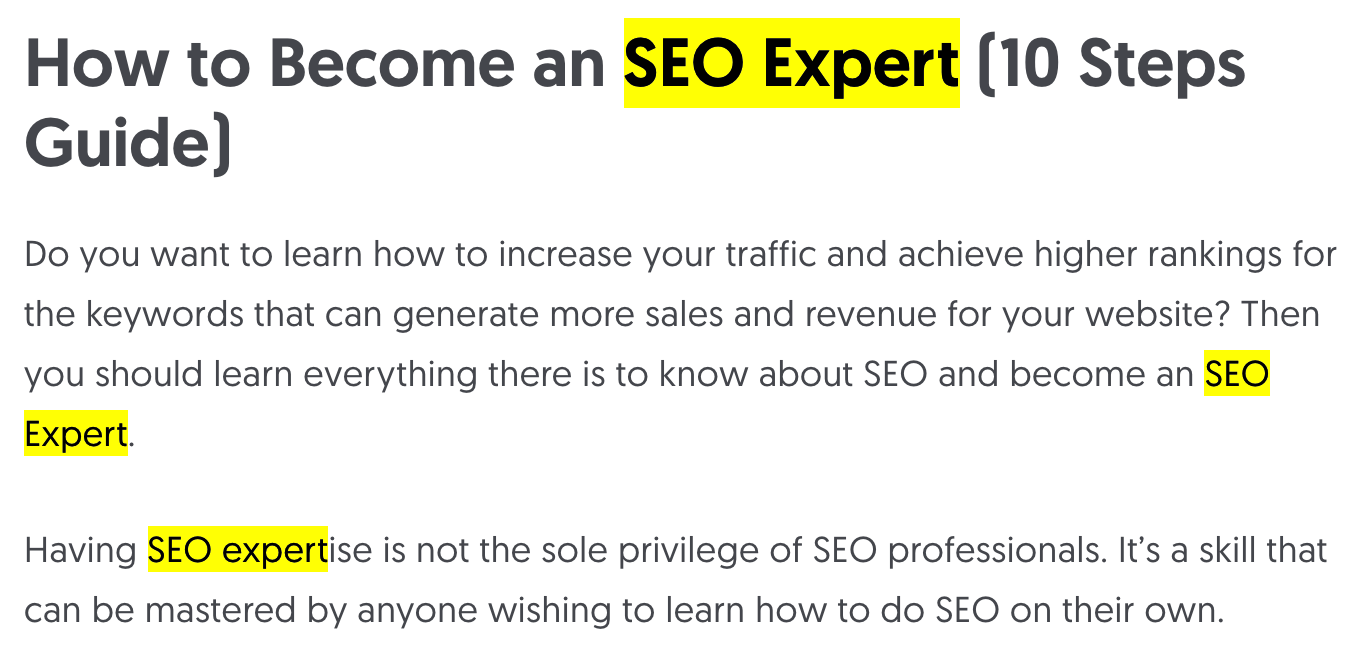
Notice how the target keyword “SEO Expert” is highlighted in the meta description.

2. Optimize your content for featured snippets using lists
Did you notice that Google loves to show lists in its search results?
Search for any query that is related to a ‘how-to’ or ‘list’ type of post and notice how the Google featured snippet is adapted to show lists.
Here are some examples to understand this better.
If you search for “How to become an SEO expert” you get this:
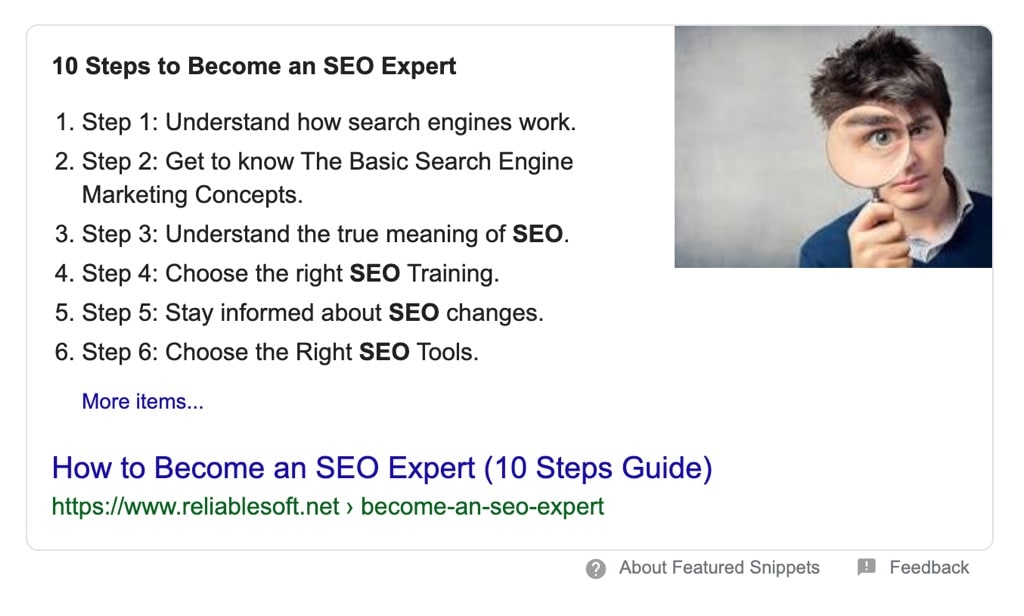
If you search for “Technical SEO best practices” you get this:

What is nice about this is that there is a way to get your list to show as a featured snippet and dramatically increase your CTR (Click Through Rates).
Follow these steps:
Make sure that you place your list high in your post – It doesn’t have to be at the very top but try not to ‘bury’ the list in the content.
Add an optimized H2 or H3 heading as the list title – Make it specific. If the list is about SEO tips then name the list “Best SEO Tips” or something related, but keep it short and to the point.
Make sure that each list item has an h2 or h3 as the title – I usually format the list title as H2 and the list item titles as H3. Keep the list item titles short and specific.
Use <ul> and <li> tags for the list items – Create your list using <UL><LI> tags. Don’t use tables or paragraphs but use the <ul> HTML tag to help Google crawlers understand that it’s a list.
Keep the list formatting simple – Don’t use arrows, custom bullets or another styling that may confuse Google.
Link each list item title to the corresponding item– Optional but highly recommended. Think about this like creating a table of contents for a book.
Here is a screenshot of how it looks in design mode:

3. Optimize your posts/pages for sitelinks using named sections
This advanced tip is extremely easy to implement. All you have to do is create ‘named’ sections within your posts.
You can create ‘named’ sections by either adding the ID attribute to a heading like this:
<h2 id="my-named-section">My heading title</h2>
Or by adding a name anchor tag like this:
<a name="my-named-achor"></a>
When you do this, each ‘named’ section can be accessed directly through the post URL.
For example, in my SEO tips for beginners post, I have added an ID to every H3 tag. Each tag can be accessed by typing the URL of the post and the name I have given for the section.
For example, this URL – https://www.reliablesoft.net/seo-tips-for-beginners/#tip9 – will take you to the link building tip.
What is great about this method is that Google can read the ‘named’ section and show them as sitelinks in your search snippet, like this:

This makes your search snippet more interesting and it attracts more clicks.
4. Use FAQPage schema to increase the real estate of your search snippets
Another way to improve the visibility of your search snippets is to use structured data markup.
You most probably read about schema markup and SEO and how it can help you get rich snippets in Google search results, but a not so known technique is to make sure of the FAQPage schema.
The FAQPage schema is for pages that have FAQ-style content (list of questions and answers for a particular topic) that is not user-generated.
While at first, it looks like it is something you cannot use, with a little bit of effort you can make sure of the FAQPage schema, on almost any type of content.
Why would you need to do this?
Because it can enhance and increase the space your snippet occupies in the search results and this means more clicks and traffic to your website.
Look at the example below from my What is SEO page.

Notice how dominant is my search snippet compared to the rest.
Follow the steps below to implement this on your pages:
Google is very fast in recognizing schema markup related changes and it’s a matter of minutes to see your enhanced snippet in the search results.
PRO TIP: In your FAQ answers you can also include links using the <a href> tag. Add links to make it easier for users to get to your page.
5. Get more traffic from topics you already have a high Google trust
This is an advanced SEO technique and a concept that many people fail to understand.
Here is the general rule:
It is easier to rank for a keyword that is related to a topic that you already have high rankings and Google trust.
Let me explain this using an example.
My website has a top ranking for the keyword “Search Engines”.
This gave me the ‘power’ to rank high of other related keywords like “How Search Engines Work” and “How to Increase visibility in Search Engines”.
Notice, how closely related are the other topics with the main topic. They all have the keyword “Search Engines” in common.
If you find the top-ranking topics your website is known for in Google, you can rank for related topics without building links.
All you have to do is to publish great content that satisfies the user intent.
Follow these steps:
To find the topics your website is known for, login to Google Search Console, go to Search Results Report and Find your top pages.
Click on Queries to see the actual search terms. These are the keywords that your website has authority.
Next, use tools like SEMRUSH to analyze those terms and find matching long-tail keywords.
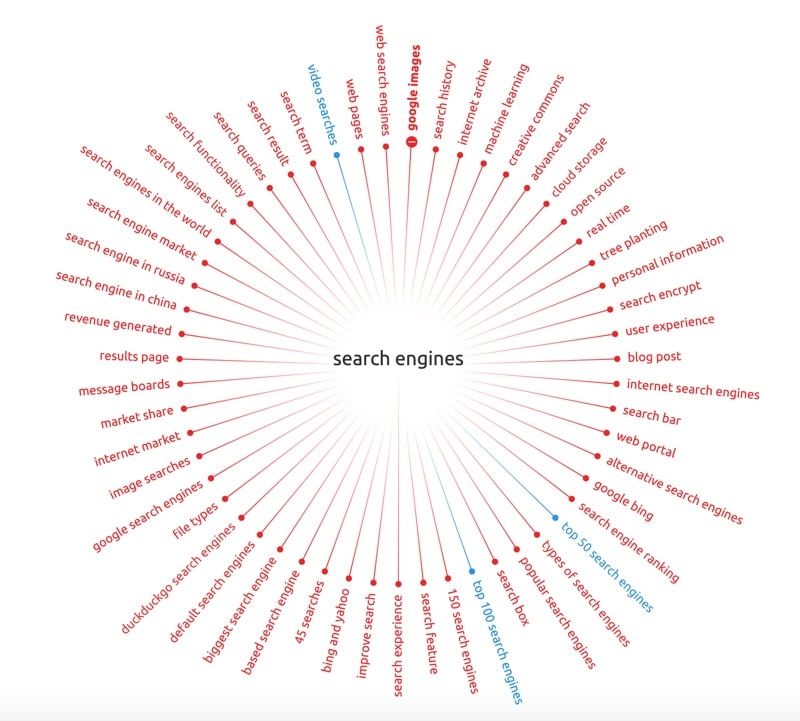
Create content around those keywords, use best SEO practices and you’ll see that in a few weeks, your new pages will achieve a first-page ranking.
6. Update your top-ranking pages
This is a simple rule to follow. You need to update your top-ranking pages regularly, in order to maintain their rankings.
For every keyword that you are ranking high on Google, there are hundreds if not thousands of pages that are competing for one of the top spots.
Google wants to show up-to-date information to users so if you don’t ensure that your content is relevant and fresh, you will gradually lose your rankings.
How to keep your content fresh?
- Check your competitor pages and see if there is anything important missing from your content. Update your content to include this information.
- Check and fix broken links
- Update your links to point to more relevant pages
- Update your images and other media elements
- Reply to user comments (if not done already)
- Update your meta descriptions (in case you include dates)
7. Enable comments on your blog
I know that a lot of people don’t have comments enabled on their blog either because they are afraid of spam or because they believe it does not offer any SEO value, but it does.
Here is a relevant tweet from a Google employee:
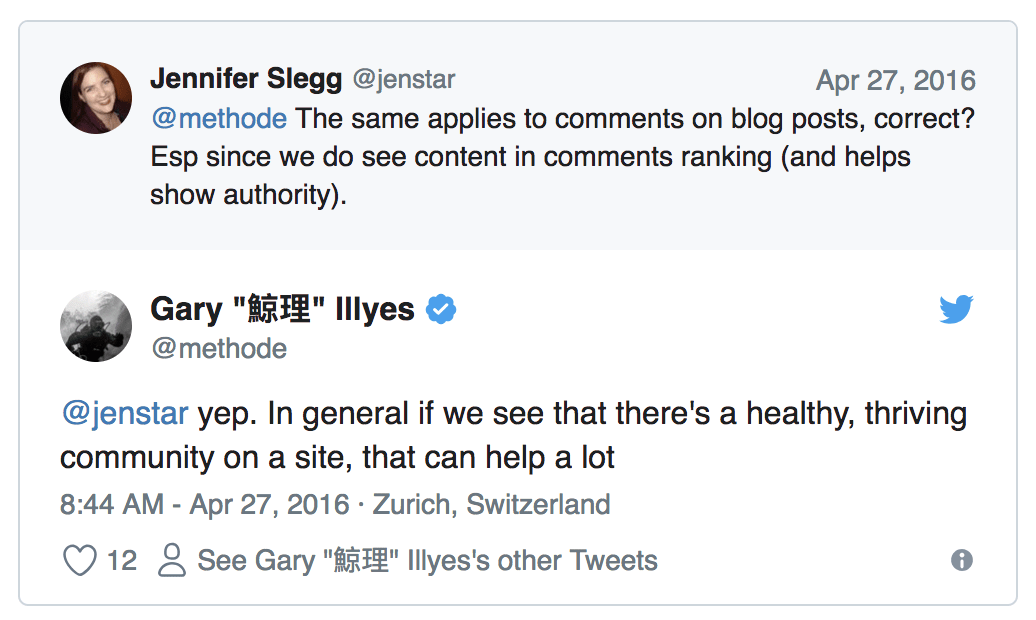
Besides the advice from Google, it is proven that pages that have valid and useful comments are more likely to rank higher than pages with no comments.
Comments on the page are one of the signals used by Google to understand how popular a page is. If a page has a lot of comments and discussions, this is a good signal that people like the content and that’s why there is interaction.
Once you enable comments, make sure that you reply to each and every comment and that you don’t publish any spam or low quality comments that don’t add value to the content or conversation.
All of my high ranking pages have a lot of comments. This is one of the most popular commented page on my blog with 130+ comments.
Comments are a great way to interact with your users and build your community. People who comment are also more likely to share and link to your content.
8. Link to high authority websites
We all know that backlinks are important for rankings but what is also important is to link out to high authority websites from your content.
The concept of links is one of the factors that let Google become the best search engine. Google uses links to discover the important pages of the web.
For this reason, they encourage webmasters to link out to high quality pages where applicable.
By linking out to high quality sources it helps your SEO in two ways:
First, you give users an option to learn more about a topic from a trusted source.
Second, you position your content as ‘high quality’. Of course this is not the only factor that makes your web high quality but it helps.
When linking out, make sure not to over optimize the anchor text and only link out to websites that demonstrate E-A-T (Expertise – Authoritativeness – Trustworthiness).
PRO TIP: To learn more about E-A-T and it’s important for ranking read: Google ranking factors
9. Consolidate duplicate content with canonical URLs
Using canonical URLs is an advanced technical SEO technique but something that every webmaster needs to know.
One of the problems that most websites face is duplicate or thin content. There are pages on your website that have the same or very similar content.
For example, if you have an eCommerce website you’ll most probably have duplicate content on your category pages.
The problem with duplicate content is that sometimes Google gets confused as to which page to rank in the results and they may select the ‘wrong’ page or none at all.
To solve this issue, you can make sure of canonical URLs to specify which of the pages you want to appear in the results.
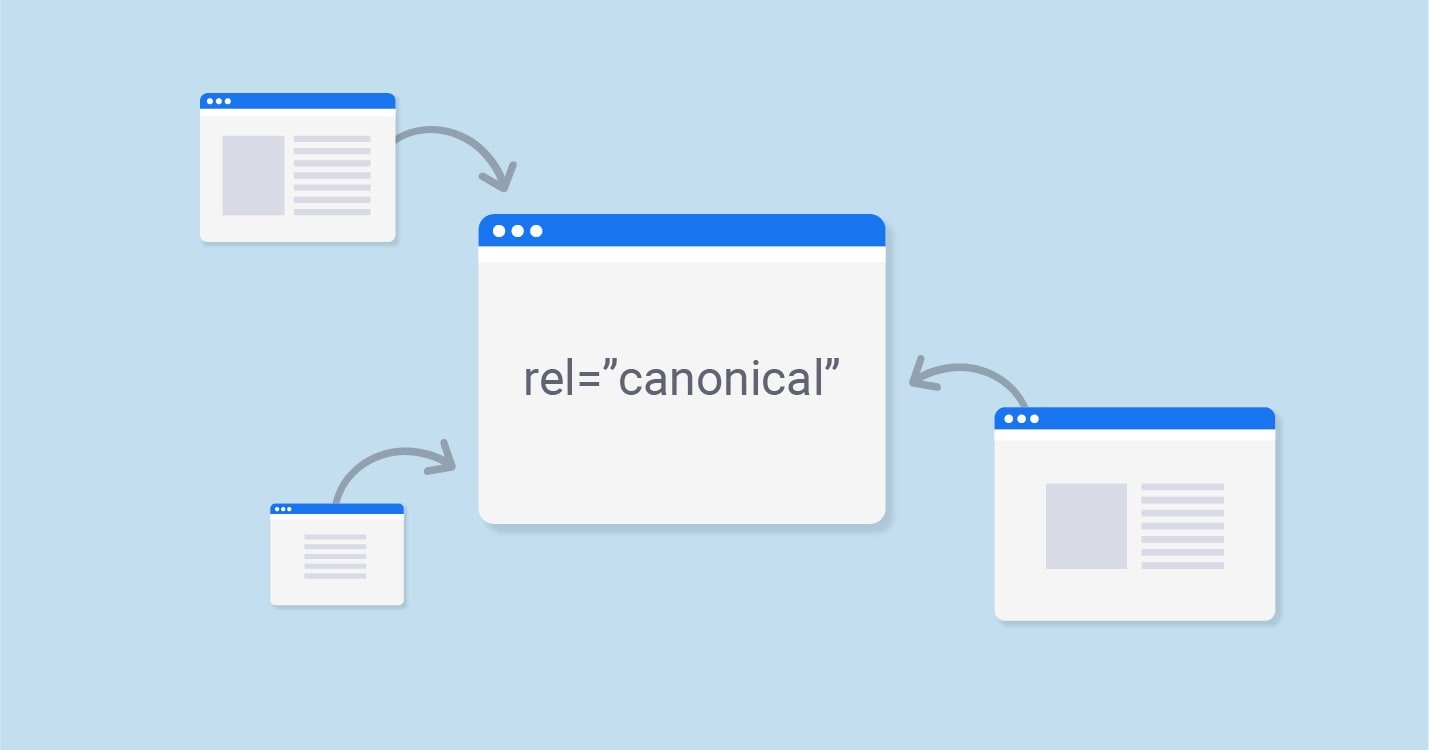
A canonical URL is added in the HEAD section of a page and tells search engines which is the preferred URL for the particular page.
A canonical URL can point to itself (self-referencing) or to a different URL.
PRO TIP: For more information on how to correctly make use of canonical URLs, read: What is a Canonical URL.
10. Distribute link juice to the pages that need them most
The internal link structure of a website plays a very important role in rankings. Websites need to have a simple site structure that connects all website pages together.
Internal linking, although is very simple to implement SEO practice, it is not used correctly by the majority of websites, that’s why is it included in the Advanced SEO practices.
The idea is the following:
You can use internal links to pass ‘PageRank authority’ from your top pages to pages you want to improve their Google rankings.
Here is what to do:
Use SEMRUSH or Google Search console to find pages of your site that have high Google rankings and incoming links.
These are the most powerful pages of your website.
Go through their content and naturally add internal links to other pages of your website you want to improve their ranking.
It’s that simple!
This simple step will eventually pass authority from one page to the other and improve its ranking.
11. Use Lazy Loading for images and videos
One of the known ranking factors is speed. Users hate slow websites and that has an impact on the time they spend on-site and of course sales and conversions.
Google on the other wants websites that appear in their results to load as fast as possible.
For desktop, you can optimize your site speed using CDNs and caching plugins but for mobile, this is not enough.
Images and other multimedia elements like Video can slow down a mobile site considerably and the solution to this problem is Lazy loading.
Lazy loading is a mechanism that loads images or videos only when they are in the user’s viewport. This means faster initial loading times for both mobile and desktop.
The good news is that it’s very easy to implement Lazy loading.
If you’re on WordPress you can either use WP-ROCKET (this is the plugin I’m using on this site) or Native Lazy Load plugin (by Google), to activate this feature on your WordPress website.
You don’t need to do any configuration, other than installing any of the above plugins.
If you are not on WordPress, you can make use of lazy loading through a CDN (Content Delivery Network). Cloudflare is a good option.
12. Use exact match URLs
This is old school SEO but still important. To make SEO friendly URLs ensure that they contain your target keywords and they are as short as possible.
Why is this important?
The way search engines work is by looking at key signals when they first discover a page.
One of them is the page title (the most important one), and another signal is the URL.

Several studies have also shown the coloration between short URLs and high rankings.
What you need to do is:
- Use your keywords in the URL
- Avoid unnecessary characters
- Avoid using dates (unless you are a News publisher)
- Use a hyphen (-) to separate the words in the URL.
Here is an example of optimized URLs from my website:

13. Use Google trends to find trending topics/keywords
When it comes to SEO, we all know that keyword research is very important. Finding the right SEO keywords can make a huge difference in rankings, traffic, and conversions.
An advanced keyword research technique is to make use of Google Trends to find topics/keywords that are gaining popularity.
By using this method and by reacting fast, i.e. creating good content to target rising keywords, you are a step ahead of your competitors.
Google is more than happy to index new content related to trending topics and you are more likely to rank higher for these topics because there is not so much competition (yet).
The process to follow is:
- Go to Google Trends
- Search for your topics or keywords
- Scroll down and look for the ‘Rising’ topics
- Find keywords related to your website (that you are not already covering) and publish new content around these keywords.
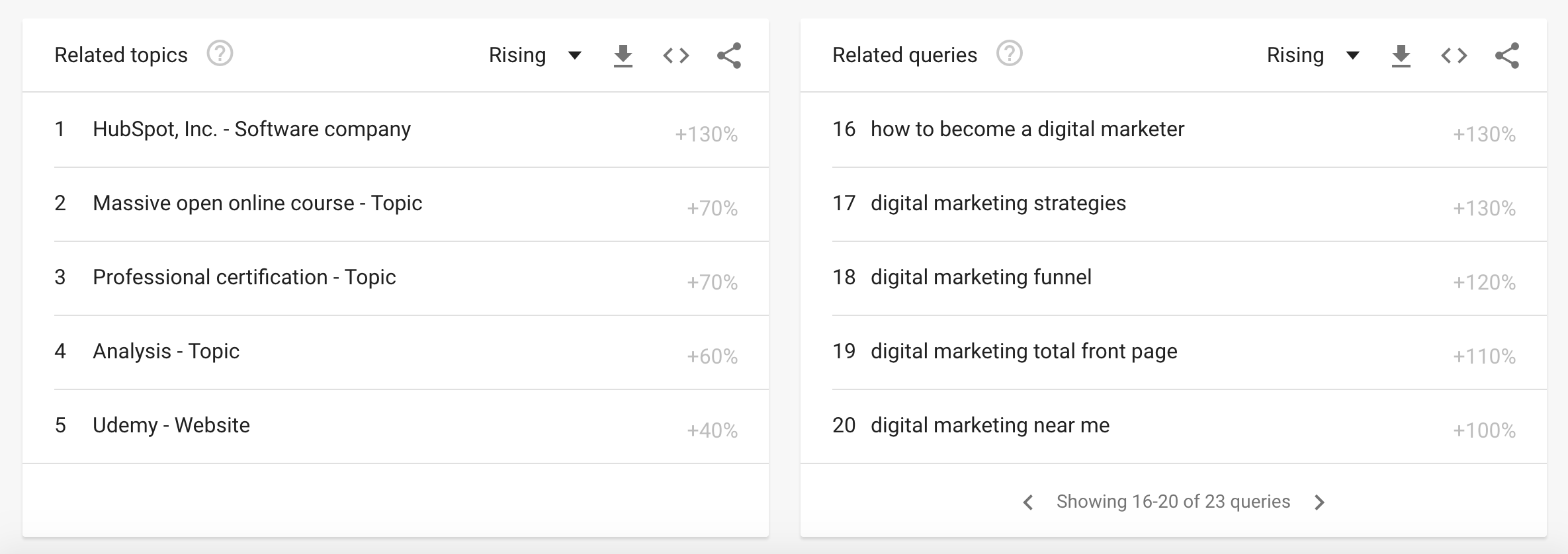
PRO TIP: When doing keyword research using Google Trends, don’t just search for the ‘obvious’ terms that everybody else is searching but try to think of search phrases that ‘normal’ Google users are using on the Google search box.
14. Find and fix technical SEO errors
Going back to technical SEO, one of the things you need to regularly do is check for crawl errors.
This is SEO 101 but I have added in the advanced list because most webmasters do this once and forget about and this the wrong approach.
Crawling and indexing is a ‘live’ process and it changes all the time. To ensure that your website can be indexed by Google without any issues, you need to use the COVERAGE report or URL INSPECTION TOOL of Google search console to find and fix crawl errors.
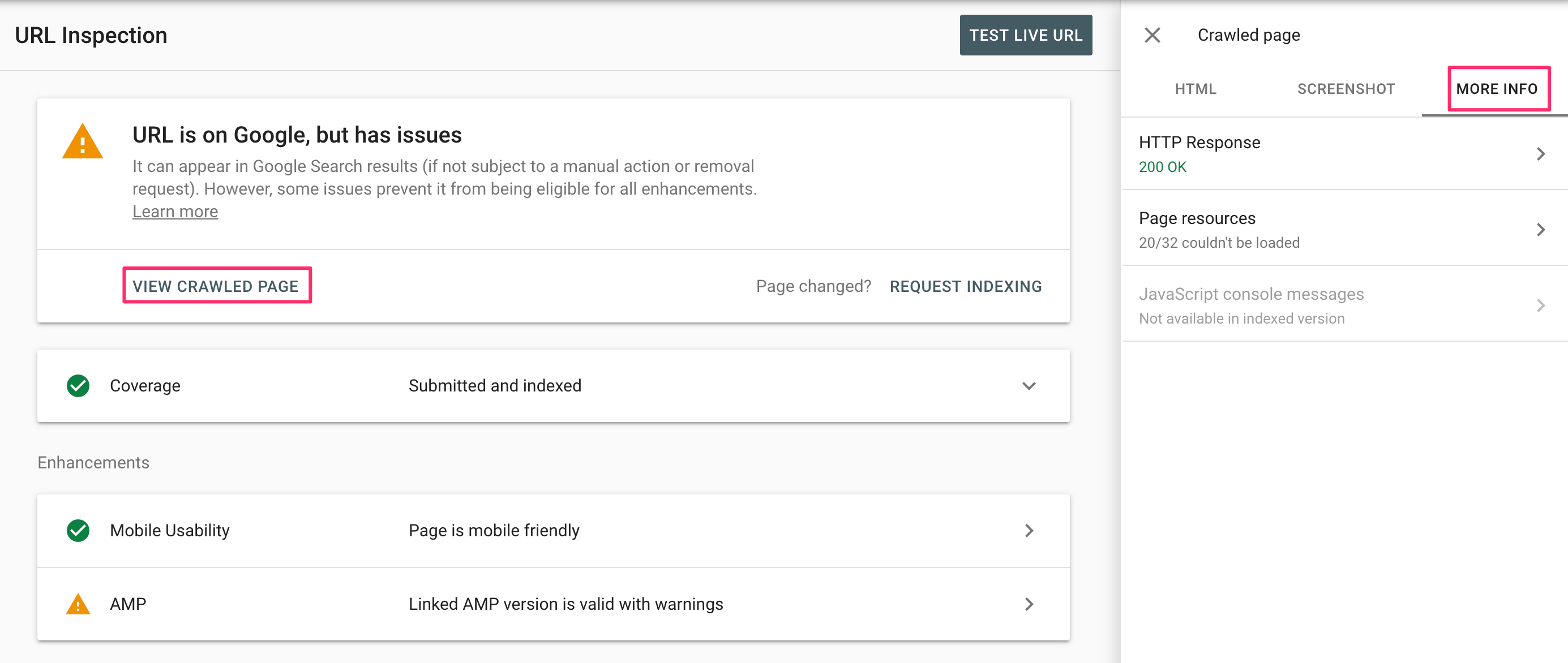
Don’t omit this step, you’ll be surprised how many issues you can find on webpages that were error-free for a lot of time.
PRO TIP: Use this guide to find and fix Google crawl errors.
15. Reduce the bounce rate for Google Organic Landing Pages
Handling bounce rate issues is one of the trickiest and advanced SEO tasks you have to do for your website.
Google besides looking at the on-page SEO of a website and backlinks, also takes into account factors related to user satisfaction.
A user that makes a search on Google and clicks on a search result to visit a website and comes back on Google immediately is a strong signal that the particular user was not satisfied with the page he visited.
If a lot of users behave the same way, then Google will reduce the rankings of that page and place other pages on top of the results that are more likely to satisfy the intent of the user.
This is an ongoing process we can control but what we can control is the time a Google user spends on our website and particular pages.
One of the metrics to use for this case is the bounce rate.

A bounce rate is a percentage that shows how many users landed on a webpage and then exited the website, without having any interaction on the page.
This means that they did not click any links on the page and this includes menu items and any other internal or external links.
A high bounce rate is bad, a low bounce rate is good.
To improve your SEO, follow these steps:
Use Google analytics reports to find out the bounce rate of your Google / Organic landing pages. These are the pages the users see first when they visit your website from Google.
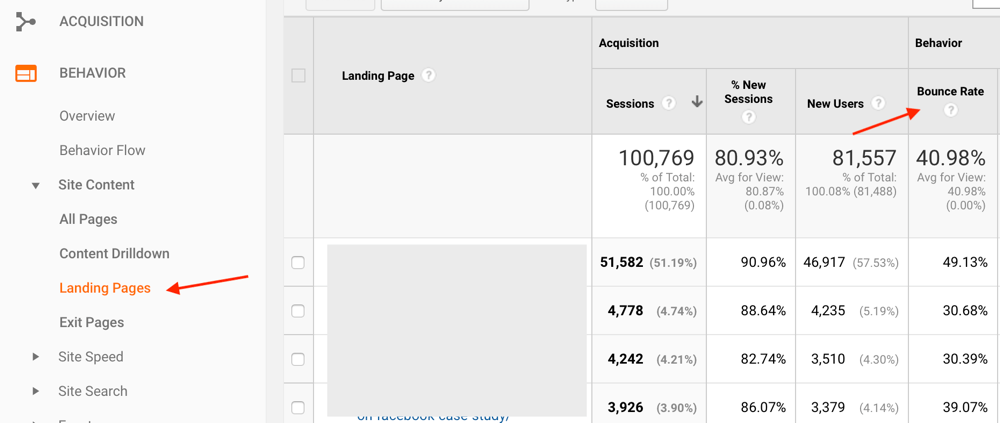
Find pages that have a high bounce rate and think of how you can improve the content to keep the users longer on the page.
Look at your competitors and try to understand what might be the reason users leave your website.
You might find out that you need to improve your content, add more content, add more visual elements, restructure your pages to make them easier to read, re-work your H1 tags and other headings to make skim-reading easier.
Keep track of the pages changed and revisit the reports in a few weeks to check if your changes created better results or not.
Don’t forget to use Google search console to resubmit the pages you updated in Google, this will dramatically speed up the time it takes for Google to index your changes.
Key Learnings
As you might have already guessed advanced SEO is not that hard to do. The word ‘advanced’ makes you think that something is complicated or too difficult but that’s not the case with the SEO tips described above.
All of the techniques are proven and tested to work and can make a real difference to your rankings and traffic.
Don’t forget that when it comes to search engine optimization, every little bit helps so don’t underestimate the importance of an SEO rule even if it looks not that critical.
If something is not clear let me know in the comments and I’ll try to help you understand how to implement them on your website.

